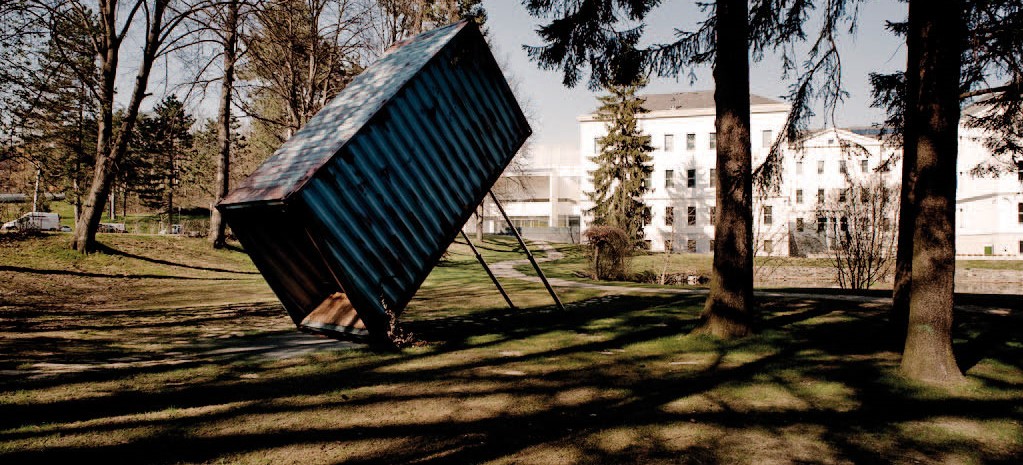Memorial Gugging
Prior to the founding of the Institute of Science and Technology Austria (ISTA), a different establishment existed in the compound. A neurological and psychiatric hospital of the province of Lower Austria operated here for approximately 120 years.
Between 1939 and 1945, unforgivable medical crimes were committed by Nazi doctors in this hospital. Several thousand patients of all ages were killed here, either intentionally or due to negligence; others were transferred to extermination centers. This memorial is dedicated to these victims.
The memorial is located in ISTA’s park. It is open to the public at all times.
The Nazi medical crimes
During the Nazi regime, 216,000 people were systematically murdered because they had physical, mental, emotional disabilities or illnesses. The aim was to “destroy unworthy life” based on a racist and inhuman ideology, as well as economic considerations.
The T4 campaign (1939-1941) was a widely known part of this organizational machinery of extermination, in the course of which 70,000 people were murdered. This systematic mass extermination of people was carried out in six killing centers, including Hartheim Castle near Linz. The killing centers of the T4 campaign were subsequently a preliminary stage of the extermination camps in Poland for the systematic murder of Jews and Roma.
The hospital in Maria Gugging was, as part of the T4 campaign and beyond, the scene of unforgivable medical crimes committed by Nazi doctors between 1939 and 1945.
In the autumn of the year 2007 the Executive Committee of the Institute of Science and Technology Austria (ISTA) commissioned the Viennese historian Herwig Czech to undertake a study of the Nazi medical crimes in the psychiatric hospital in Gugging. The paper was forwarded to the artists participating in the competition as an initial point for their consideration.
The central findings of the study are: The hospital in Gugging was one of the centers of Nazi medical crimes. Between November 1940 and May 1941 a total of 675 persons were taken in 12 transports from the clinic to Schloss Hartheim near Linz, where they were gassed. Of these, 116 were children and adolescents between the ages of 4 and 17. Between May 1941 and the end of the war, Gugging was the scene of some of the most barbarous medical crimes committed in the territory of present-day Austria. The main perpetrator, Dr. Emil Gelny, murdered some 400 people using poison and a specially adapted device for administering electrical shocks. Many other patients died as a result of hunger and infectious disease or were deported to institutions where their chances of survival were minimal. After the war, Dr. Gelny was able to flee the country, first to Syria and then to Iraq. He was never prosecuted for his crimes.
At the first ISTA Commemoration Lecture on 25 November 2014, Herwig Czech presented additional findings which he included in an expanded version of his paper. The ISTA Commemoration Lecture can be viewed HERE.
Related links:
- Documentation Centre of Austrian Resistance
- Memorial at Steinhof (German)
- Memorial at Schloss Hartheim
The work of art and the artist
The memorial, designed by Dorothee Golz, was chosen by an international jury, in a competition held in the spring of 2008.
The jury described the work as “sensitive and idiosyncratic, far from all traditional or topical formulation, or typical features for a memorial”. Dorothee Golz approaches a complex problem metaphorically and makes concepts such as memories, the past, despair and loss comprehensible.
The central element of the Memorial is an old freight container, tilted on one end at an angle of 45 degrees. Looking up into the container the viewer is able to discern a sketch of a table and a chair with a broken line of spheres, symbolizing life, which ended abruptly and unexpectedly. The German word „Leben“ (life) can still be read despite the spheres being dispersed on the floor. At the upper end, a steel door opens to the sky, to a new future and a new hope.
Dorothee Golz about the Memorial Gugging:
“A freight container is a standardized object that cannot be assigned to a specific time or place – just as a crime remains a crime at any time and in any place.”
The memorial, describing terrible crimes and relating to another period and another Institution, is erected in deliberate contrast to the serene and pastoral atmosphere of the new scientific Institute built on the same site.
You can read more about the official opening of the memorial in June 2010 in our related press release.



On Dorothee Golz
| 1960 | born in Mülheim an der Ruhr (Germany) |
| 1981-1986 | Ecole Supérieur des Arts Décoratifs de Strasbourg (France) |
| 1981-1985 | History of art and cultural anthropology at the University of Freiburg (Germany) |
| 1986 | Diplome National Supérieur des Arts Plastiques |
The artist had exhibitions in Germany, Austria, Switzerland and Japan. Dorothee Golz lives and works in Vienna (Austria).
For more information see www.dorothee-golz.com


